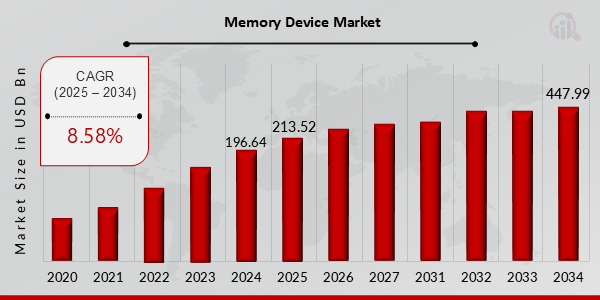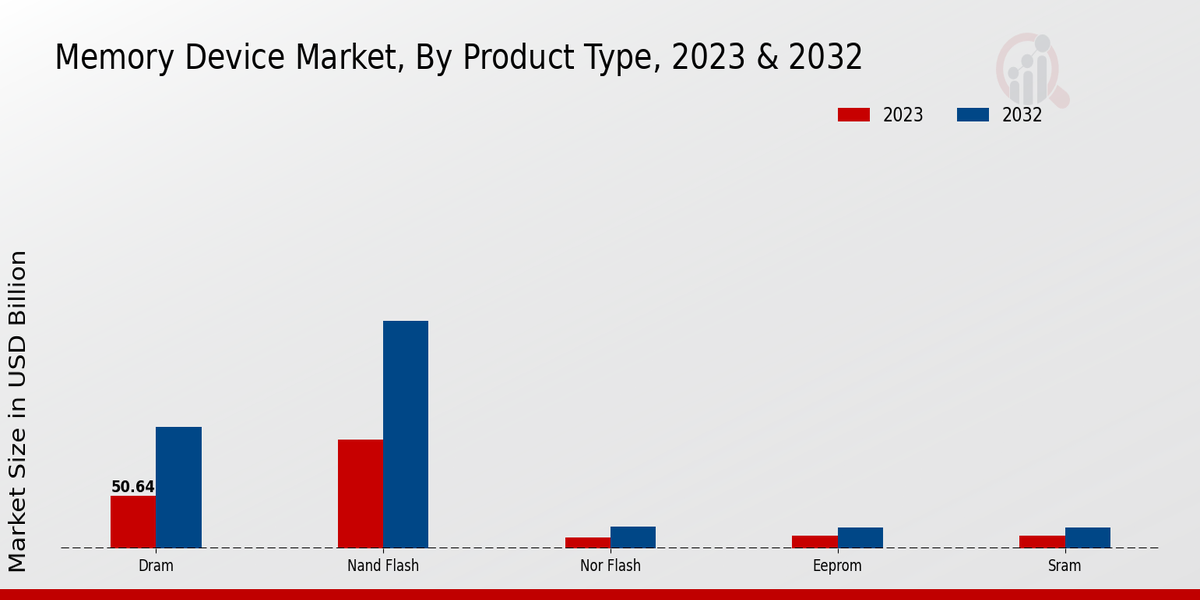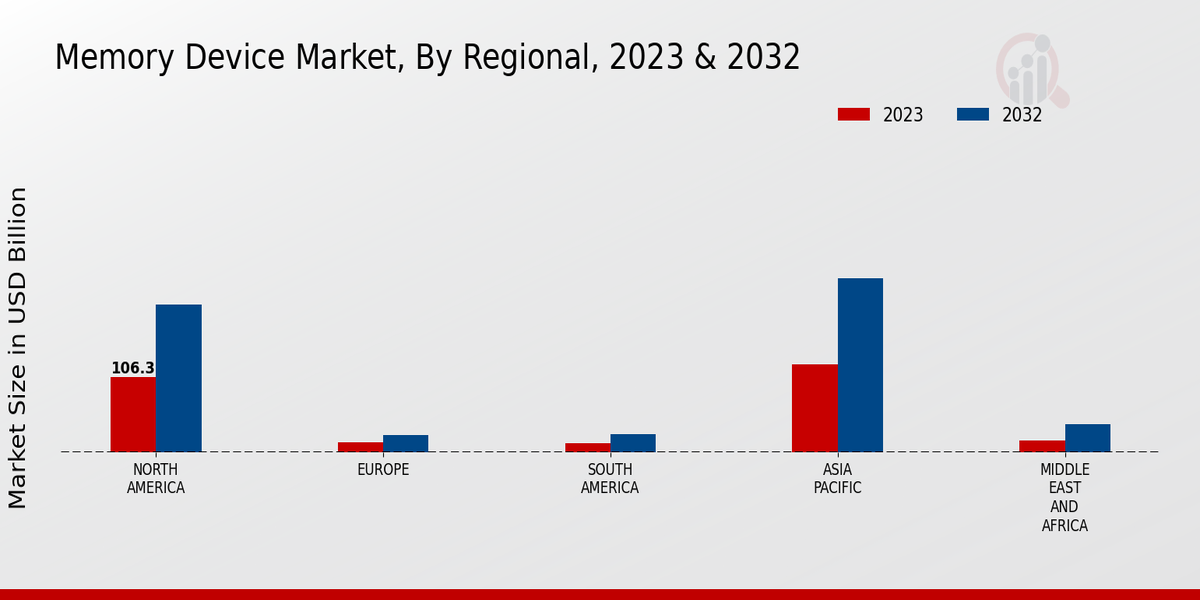Global Memory Device Market Overview:
Memory Device Market Size was estimated at 196.64 (USD Billion) in 2024. The Memory Device Market Industry is expected to grow from 213.52 (USD Billion) in 2025 to 447.99 (USD Billion) till 2034, exhibiting a compound annual growth rate (CAGR) of 8.58% during the forecast period (2025 - 2034).
Key Memory Device Market Trends Highlighted
Memory Device Market Trends: High-performance memory devices also benefit from the current rapid developments and usage of artificial intelligence (AI) and machine learning (ML) technologies in numerous industries. Some of the Opportunities to be explored lie in emerging types of memory devices that combine a PCM and an RRAM unit and that have faster operations than any other types currently available on the market. An expansion in the use of 3D NAND flash memory has gained acceptance in the memory device market in recent times because of the high storage density and fast transfer speeds that it offers. Furthermore, with the increasing inclination towards storage devices such as flash drives and solid-state drives, which are types of non-volatile memory (NVM), markets will expect growth in recent years.

Source: Primary Research, Secondary Research, MRFR Database and Analyst Review
Memory Device Market Drivers
Advancements in Artificial Intelligence (AI) and Machine Learning (ML)
AI and ML are expanding rapidly across various sectors, leading to an increasing need for high-performance memory devices. AI algorithms need large computational resources and broad memory bandwidth for processing big data sets, training sophisticated models, and high-speed real-time inference. The incorporation of AI and ML in diverse domains, such as natural language processing, image recognition, and predictive analytics, is increasing the need for memory devices with fast speed, large size, and high reliability.For example, the Artificial Intelligence market is set to grow robustly between 2023 and 2030. As per a survey, the global artificial intelligence market was worth 390.9 billion in 2023 and will reach back to 1,597.3 billion by the end of 2030, recording a CAGR of 20.1%.
Proliferation of Cloud and Edge Computing
The high rate of adoption of cloud and edge computing is creating a huge demand for memory devices. Cloud computing is the provision of computing services, including computing power, storage, and applications over the internet, utilizing a cluster of servers to manage and store data. This implicates a need for high-capacity and fast memory devices that can provide high performance. Edge computing, on the other hand, takes the cloud network to the edge, closer to the data source.This means memory devices need to have fast access times and endurance to service real-time computing. Hence, there is a lot of growth potential in the Memory Device Market Industry as a lot of companies are adopting cloud and edge computing.
Growing Demand for Mobile and Consumer Electronics
The burgeoning demand for mobile devices, such as smartphones, tablets, and laptops, is driving the need for advanced memory devices. These devices require high-performance memory solutions to support demanding applications, multitasking, and seamless user experiences. Moreover, the growing popularity of consumer electronics, including smart TVs, gaming consoles, and wearable devices, is further contributing to the demand for memory devices. The integration of advanced memory technologies, such as DRAM and NAND flash, in these devices enhances their performance, storage capacity, and overall user experience, thus propelling the growth of the Memory Device Market Industry.
Memory Device Market Segment Insights:
Memory Device Market Product Type Insights
The Memory Device Market is segmented by Product Type into DRAM, NAND Flash, NOR Flash, EEPROM, and SRAM. The DRAM segment is the largest segment and is expected to grow at a CAGR of 8.4% over the forecast period. The NAND Flash segment is the second-largest segment and is expected to grow at a CAGR of 9.2% over the forecast period. The NOR Flash segment is the third-largest segment and is expected to grow at a CAGR of 8.9% over the forecast period. The EEPROM segment is the fourth-largest segment and is expected to grow at a CAGR of 8.7% over the forecast period.The SRAM segment is the smallest segment and is expected to grow at a CAGR of 8.6% over the forecast period. The growth of the DRAM segment is attributed to the increasing demand for memory in data centers and cloud computing applications. The growth of the NAND Flash segment is attributed to the increasing demand for solid-state drives in laptops, smartphones, and other mobile devices. The growth of the NOR Flash segment is attributed to the increasing demand for embedded memory in automotive and industrial applications. The growth of the EEPROM segment is attributed to the increasing demand for non-volatile memory in industrial and automotive applications.The growth of the SRAM segment is attributed to the increasing demand for high-speed memory in gaming consoles and other consumer electronics devices. The Memory Device Market is a highly competitive market with a number of major players. The key players in the market include Samsung, SK Hynix, Micron Technology, Toshiba, and Western Digital. These companies are investing heavily in research and development to develop new memory technologies and products. The market is also expected to see the entry of new players in the coming years, which will further increase the level of competition.

Source: Primary Research, Secondary Research, MRFR Database and Analyst Review
Memory Device Market Application Insights
The application segment of the Memory Device Market holds significant importance, with each segment catering to distinct end-user requirements. Consumer Electronics is a prominent segment, driven by the surging demand for smartphones, laptops, and other gadgets. In 2023, this segment accounted for approximately 35% of the Memory Device Market revenue. Enterprise Storage is another crucial segment, fueled by the exponential growth of data generation and the need for efficient data management. This segment is projected to exhibit a CAGR of over 9% during the forecast period, reaching a valuation of USD 63.5 billion by 2032.Industrial applications represent a growing segment driven by the increasing adoption of automation and IoT devices. The Automotive segment is gaining traction due to the rising demand for advanced driver assistance systems (ADAS) and infotainment systems in vehicles. Healthcare is another promising segment, with the increasing use of memory devices in medical imaging, patient monitoring, and drug discovery.
Memory Device Market Form Factor Insights
The Form Factor segment of the Memory Device Market encompasses Integrated Circuits (ICs), Memory Cards, and Memory Modules. In 2023, ICs held the largest revenue share, driven by their extensive use of smartphones, laptops, and other electronic devices. Memory Cards, primarily used in cameras and portable devices, are projected to experience steady growth due to increasing demand for high-resolution images and videos. Memory Modules, employed in servers and data centers are anticipated to witness significant market expansion as cloud computing and data analytics gain traction.The Memory Device Market is expected to reach a valuation of USD 185.15 billion in 2024, exhibiting a CAGR of 9.2% during the forecast period from 2024 to 2032.
Memory Device Market Memory Capacity Insights
The Memory Capacity segment of the Memory Device Market is expected to witness substantial growth in the coming years, driven by the increasing demand for high-capacity memory devices across various end-use industries. Among the different memory capacities, the ‘Less than 1GB' segment held a significant market share in 2023, owing to its widespread use in low-end devices such as feature phones and entry-level laptops. However, the '1GB to 8GB' segment is projected to exhibit the highest CAGR during the forecast period, driven by the growing adoption of mid-range smartphones and tablets.The '8GB to 64GB' segment is also expected to witness significant growth, primarily due to its increasing use in high-end smartphones, gaming consoles, and personal computers. The '64GB to 256GB' and 'More than 256GB' segments are expected to grow at a moderate pace, catering to the demand for high-capacity storage in devices such as laptops, desktops, and servers. Overall, the Memory Capacity segment presents immense growth opportunities for market participants as the demand for high-performance and high-capacity memory devices continues to rise across various industries.
Memory Device Market Speed Grade Insights
Segmentation based on Speed Grade includes High Speed (DDR5, LPDDR5), Medium Speed (DDR4, LPDDR4), and Low Speed (DDR3, LPDDR3). High-speed memory has emerged as the preferred choice for advanced computing applications due to its ability to handle large volumes of data at faster speeds. Medium-speed memory finds application in mid-range devices that require a balance of performance and cost. Low-speed memory is commonly used in budget-friendly devices and legacy systems, offering a cost-effective solution. The market data suggests that the High Speed segment is expected to expand at a significant rate owing to the rising adoption of 5G technology, cloud computing, and artificial intelligence (AI).
Memory Device Market Regional Insights
The regional segmentation of the Memory Device Market offers diverse market dynamics and opportunities. North America holds a significant market share, driven by the presence of leading technology companies and the high adoption of advanced memory solutions. The region is projected to maintain its dominance in the coming years. Europe follows closely, with a strong demand for memory devices in various industries, including automotive, healthcare, and consumer electronics. The Asia-Pacific region emerges as a rapidly growing market fueled by increasing smartphone penetration and the expansion of data centers.South America and MEA exhibit steady growth potential, with growing investments in infrastructure and technology adoption. These regional insights provide valuable data for market players to tailor their strategies, optimize resource allocation, and capture growth opportunities.

Source: Primary Research, Secondary Research, MRFR Database and Analyst Review
Memory Device Market Key Players and Competitive Insights:
Major players in the Memory Device Market industry are constantly innovating and developing new technologies to meet the growing demands of the market. Leading Memory Device Market players are focusing on expanding their product portfolio and geographical reach to gain a competitive edge. The Memory Device Market is expected to witness significant growth in the coming years, driven by the increasing adoption of memory-intensive applications and the growing demand for high-performance computing.Samsung Electronics is a leading player in the Memory Device Market. The company offers a wide range of memory devices, including DRAM, NAND flash, and solid-state drives. Samsung is known for its innovative products and its strong brand reputation. The company has a global presence and is actively involved in research and development to drive Memory Device Market development.Samsung Electronics faces competition from other leading players in the Memory Device Market, such as Micron Technology, SK Hynix, and Toshiba. These companies are also investing heavily in research and development to gain a competitive advantage. The Memory Device Market is highly competitive, and players are constantly seeking to differentiate their products and services to gain market share.
Key Companies in the Memory Device Market Include:
-
Kingston Technology
-
Broadcom
-
Flextronics
-
Seagate Technology
-
Analog Devices
-
Micron Technology
-
Western Digital
-
Winbond Electronics
-
SK Hynix
-
Intel
-
Samsung Electronics
-
Qualcomm
-
Cypress Semiconductor
-
Toshiba Memory
-
ON Semiconductor
Memory Device Industry Developments
The Memory Device Market is projected to reach USD 350.0 billion by 2032, exhibiting a CAGR of 8.58% from 2024 to 2032. Growing adoption of cloud and edge computing, increasing demand for smartphones and other consumer electronics, and rising popularity of artificial intelligence (AI) and machine learning (ML) are major factors driving market growth.Key industry developments include Samsung's launch of the industry's first 16Gb GDDR6W memory chip, Micron's introduction of its new 232-layer NAND flash memory, and SK Hynix's announcement of plans to invest $15 billion in a new memory chip fabrication facility. These developments indicate continued innovation and investment in the memory device market.
Memory Device Market Segmentation Insights
Memory Device Market Product Type Outlook
- DRAM
- NAND Flash
- NOR Flash
- EEPROM
- SRAM
Memory Device Market Application Outlook
- Consumer Electronics
- Enterprise Storage
- Industrial
- Automotive
- Healthcare
Memory Device Market Form Factor Outlook
- Integrated Circuits (ICs)
- Memory Cards
- Memory Modules
Memory Device Market Memory Capacity Outlook
- Less than 1GB
- 1GB to 8GB
- 8GB to 64GB
- 64GB to 256GB
- More than 256GB
Memory Device Market Speed Grade Outlook
- High Speed (DDR5, LPDDR5)
- Medium Speed (DDR4, LPDDR4)
- Low Speed (DDR3, LPDDR3)
Memory Device Market Regional Outlook
- North America
- Europe
- South America
- Asia Pacific
- Middle East and Africa
|
Report Attribute/Metric
|
Details
|
|
Market Size 2024
|
USD 196.64 Billion
|
|
Market Size 2025
|
USD 213.52 Billion
|
|
Market Size 2034
|
USD 447.99 Billion
|
|
Compound Annual Growth Rate (CAGR)
|
8.58% (2025-2034)
|
|
Base Year
|
2024
|
|
Market Forecast Period
|
2025-2034
|
|
Historical Data
|
2020-2023
|
| Market Forecast Units |
USD Billion |
| Key Companies Profiled |
Kingston Technology, Broadcom, Flextronics, Seagate Technology, Analog Devices, Micron Technology, Western Digital, Winbond Electronics, SK Hynix, Intel, Samsung Electronics, Qualcomm, Cypress Semiconductor, Toshiba Memory, ON Semiconductor |
| Segments Covered |
Product Type, Application, Form Factor, Memory Capacity, Speed Grade, Regional |
| Key Market Opportunities |
Advanced Packaging Technologies High growth End use Sectors Emerging Memory Technologies Cloud and Data Center Growth Mobile and Consumer Electronics Demand |
| Key Market Dynamics |
Growing demand for cloud and edge computing Artificial intelligence AI and machine learning ML adoption Increasing internet penetration Rise of 5G networks Miniaturization and cost reduction of memory devices |
| Countries Covered |
North America, Europe, APAC, South America, MEA |
Frequently Asked Questions (FAQ) :
The Memory Device Market is expected to reach a valuation of 447.99 billion USD in 2034.
The Memory Device Market is projected to grow at a CAGR of 8.58% from 2025 to 2034.
The Memory Device Market Size was 196.64 billion USD by 2024.
North America is expected to hold the largest market share in the Memory Device Market in 2023.
Asia Pacific is expected to grow at the highest CAGR in the Memory Device Market from 2024 to 2032.
Key applications of Memory Devices include smartphones, laptops, tablets, servers, and digital cameras.
Key competitors in the Memory Device Market include Samsung, SK Hynix, Micron Technology, and Kioxia.
Key factors driving the growth of the Memory Device Market include increasing demand for mobile devices, cloud computing, and artificial intelligence.
Key challenges faced by the Memory Device Market include supply chain disruptions, price volatility, and technological advancements.
Key trends expected to shape the future of the Memory Device Market include increasing adoption of 3D NAND, emerging memory technologies, and growing demand for memory-intensive applications.

















